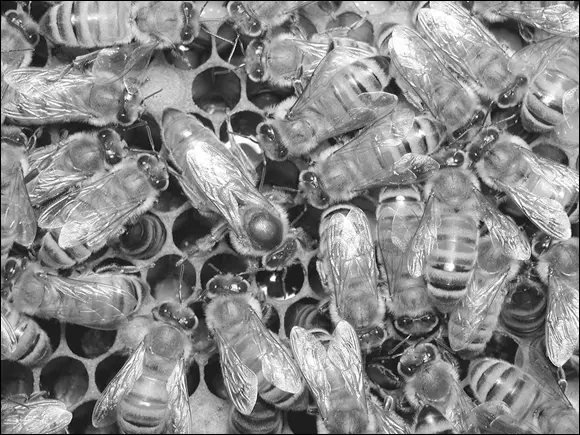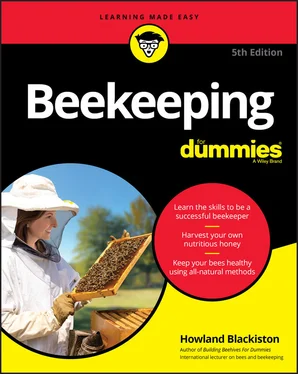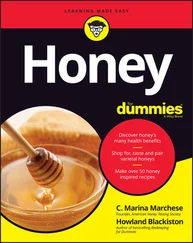FIGURE 2-5:These are the three types of bees in the hive: worker, drone, and queen.
 As a beekeeper, on every visit to the hive you need to determine two things: “Do I have a queen?” and “Is she healthy?”
As a beekeeper, on every visit to the hive you need to determine two things: “Do I have a queen?” and “Is she healthy?”
The queen is the largest bee in the colony, with a long and graceful body. She is the only female with fully developed ovaries. The queen’s two primary purposes are to produce chemical scents that help regulate the unity of the colony and to lay eggs — and lots of them. She is, in fact, an egg-laying machine, capable of producing more than 1,500 eggs a day at 30-second intervals. That many eggs are more than her body weight!
The other bees pay close attention to the queen, tending to her every need. Like a regal celebrity, she’s always surrounded by a flock of attendants as she moves about the hive (see Figure 2-6). Yet, she isn’t spoiled. These attendants are vital because the queen is incapable of tending to her own basic needs. She can neither feed nor groom herself. She can’t even leave the hive to relieve herself. And so her doting attendants (the queen’s court, her retinue) take care of her basic needs while she tirelessly goes from cell to cell doing what she does best: lay eggs.

Courtesy of USDA-ARS
FIGURE 2-6:A queen and her attentive attendants.
The gentle queen bee has a stinger, but it is rare for a beekeeper to be stung by a queen bee. I have handled many queen bees and have never been stung by any of them. In general, queen bees use their stingers only to kill rival queens that may emerge or be introduced in the hive.
The queen can live for two or more years, but replacing your queen after a season or two ensures maximum productivity and colony health. Many seasoned beekeepers routinely replace their queens every year after the nectar flow. This practice ensures that the colony has a new, energetic, and fertile young queen each season. You may wonder why you should replace the queen if she’s still alive. That’s an easy one: As a queen ages, her egg-laying capability slows down, which results in less and less brood each season. Less brood means a smaller colony. And a smaller colony means a lackluster honey harvest for you! For information on how to successfully introduce a new queen, see Chapter 10. For information on how to raise your own queens (now, that’s fun!), see Chapter 14.
 As a beekeeper, your job is to anticipate problems before they happen. An aging queen — more than a year old — is something that you can deal with by replacing her after checking her egg-laying, before you have a problem resulting from a poorly performing queen.
As a beekeeper, your job is to anticipate problems before they happen. An aging queen — more than a year old — is something that you can deal with by replacing her after checking her egg-laying, before you have a problem resulting from a poorly performing queen.
AMAZING “QUEEN SUBSTANCES”
In addition to laying eggs, the queen plays a vital role in maintaining the colony’s cohesiveness and stability. The mere presence of the queen in the hive motivates the productivity of the colony. Her importance to the hive is evident in the amount of attention paid to her by the worker bees everywhere she goes in the hive. But, as is true of every working mom or regal presence, she can’t be everywhere at once, and she doesn’t interact with every member of the colony every day. So how does the colony know it has a queen? By her scent. The queen produces a number of different pheromones (mentioned earlier in this chapter) that attract workers to her and stimulate brood-rearing, foraging, comb-building, and other activities. Also referred to as queen substances, these pheromones play an important role in controlling the behavior of the colony: Queen substance keeps the worker bees from making a new queen and inhibits the development of the worker bees’ ovaries, thus ensuring that the queen is the only egg-laying female in the hive. They act as a chemical communication that “all is well — the queen is in residence and hard at work.” As a queen ages, these pheromones diminish, and when that happens, the colony knows it’s time to supersede her with a new, young queen.
Pheromones are essential in controlling the colony’s well-being. This queen substance makes its way around the hive like a bucket brigade. The queen’s attendants pick up the scent from the queen and transfer it by contact with neighboring bees. They in turn pass the scent onto others, and so it distributes throughout the colony. So effective is this relay that if the queen were removed from the hive, the entire colony would be aware of her loss within an hour. When the workers sense the lack of a queen, they become listless, and their drive to be productive is lost. Without leadership, they nearly lose their reason for being! First they’re unhappy and mope around, but then it dawns on them: “Let’s make a new queen.”
The industrious little worker bee
The majority of the hive’s population consists of worker bees. Like the queen, worker bees are all female. Worker bees that are younger than 3 weeks old have working ovaries and can lay eggs, but they are not fertile, as the workers never mate and therefor lack sperm to fertilize eggs. Workers also look different than the queen. They are smaller, their abdomens are shorter, and on their hind legs they possess pollen baskets, which are used to tote pollen back from the field.
Like the queen, the worker bee has a stinger. But her stinger is not a smooth syringe like the queen’s. The sting is three-shafted, with each shaft having barbs (resemble a fish hook). The barbs cause the stinger, venom sack, and a large part of the bee’s gut to remain in a human victim — a Kamikaze effort to protect the colony. Only in mammals (such as humans) does the bee’s stinger get stuck. The worker bee can sting other insects again and again while defending its home.
The life span of a worker bee is a modest six weeks during the colony’s active season. However, worker bees live longer (four to eight months) during the less-active winter months. These winter workers are loaded with protein and are sometimes referred to as “Fat Bees.” The term “busy as a bee” is well earned. Worker bees do a considerable amount of work, day in and day out. They work as a team. Life in the hive is one of compulsory cooperation. What one worker could never do on her own can be accomplished as a colony. During the busy season, the worker bees literally work themselves to death. The specific jobs and duties they perform during their short lives vary as they age. Understanding their roles will deepen your fascination and appreciation of these remarkable creatures.
From the moment a worker bee emerges from her cell, she has many and varied tasks clearly cut out for her. As she ages, she performs more and more complex and demanding tasks. Although these various duties usually follow a set pattern and timeline, they sometimes overlap. A worker bee may change occupations, sometimes within minutes, if there is an urgent need within the colony for a particular task. They represent teamwork and empowerment at their best!
Initially, a worker’s responsibilities include various tasks within the hive. At this stage of development, worker bees are referred to as house bees. As they get older, their duties involve work outside of the hive as field bees.
Worker honey bees spend the first few weeks of their lives carrying out very specific tasks within the hive. For this reason, they are referred to as house bees . The jobs they do (described in the following sections) are dependent on their age.
Читать дальше

 As a beekeeper, on every visit to the hive you need to determine two things: “Do I have a queen?” and “Is she healthy?”
As a beekeeper, on every visit to the hive you need to determine two things: “Do I have a queen?” and “Is she healthy?”











